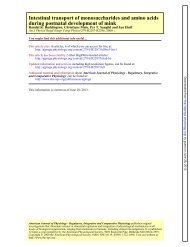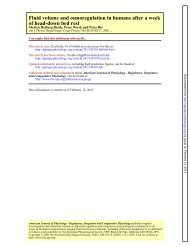Mechanical strain regulation of the Chicken glypican-4 gene ...
Mechanical strain regulation of the Chicken glypican-4 gene ...
Mechanical strain regulation of the Chicken glypican-4 gene ...
You also want an ePaper? Increase the reach of your titles
YUMPU automatically turns print PDFs into web optimized ePapers that Google loves.
The expression <strong>of</strong> <strong>the</strong> GPC-4 <strong>gene</strong> in a variety <strong>of</strong> tissues was examined by RT-PCR (Fig.<br />
9). In addition to <strong>the</strong> high levels <strong>of</strong> <strong>the</strong> GPC-4 <strong>gene</strong> that were expressed in <strong>the</strong> ESG , high<br />
levels were also observed in <strong>the</strong> liver, pancreas and kidneys. The expression <strong>of</strong> <strong>the</strong> GPC-<br />
4 <strong>gene</strong> in <strong>the</strong>se tissues was unaffected by <strong>the</strong> daily egg cycle (data not shown).<br />
DISCUSSION<br />
The avian GPC-4 <strong>gene</strong> exhibits high homology with <strong>the</strong> mammalian ones and presents<br />
highly conserved sequences such as <strong>the</strong> <strong>glypican</strong> signature and <strong>the</strong> GPI-binding site in<br />
<strong>the</strong> same locations as <strong>the</strong> mammalian homologues. Moreover, <strong>the</strong> conserved locations <strong>of</strong><br />
<strong>the</strong> cystein residues suggest similar three-dimensional structures (Fig. 2). To date, GPC-4<br />
is <strong>the</strong> second member <strong>of</strong> <strong>the</strong> <strong>glypican</strong> family identified in <strong>the</strong> chicken [<strong>the</strong> first being<br />
GPC-1 (29)], which suggests that, similarly to mammals, avian species may contain<br />
more members <strong>of</strong> this family. In <strong>the</strong> present study we demonstrated for <strong>the</strong> first time that<br />
<strong>the</strong> avian GPC-4 <strong>gene</strong> is expressed in <strong>the</strong> ESG in a circadian fashion and is probably<br />
regulated by mechanical <strong>strain</strong>. This hypo<strong>the</strong>sis is supported by <strong>the</strong> following<br />
observations: A- The <strong>gene</strong> is expressed in <strong>the</strong> ESG only when an egg resides in <strong>the</strong> ESG<br />
and imposes a mechanical <strong>strain</strong> (Fig. 3); B- Removal <strong>of</strong> <strong>the</strong> mechanical <strong>strain</strong> caused<br />
reduction in <strong>the</strong> <strong>gene</strong> expression (Fig. 6); C- Artificial application <strong>of</strong> <strong>the</strong> mechanical<br />
<strong>strain</strong> caused induction <strong>of</strong> <strong>the</strong> GPC-4 expression that was related to <strong>the</strong> level <strong>of</strong> <strong>the</strong> <strong>strain</strong><br />
(Fig. 5); and D- <strong>the</strong> GPC-4 <strong>gene</strong> was induced by mechanical <strong>strain</strong> in o<strong>the</strong>r parts <strong>of</strong> <strong>the</strong><br />
oviduct too (Fig. 8). In <strong>the</strong> ESG <strong>the</strong> GPC-4 was expressed only by <strong>the</strong> GE cells and not<br />
by <strong>the</strong> cells facing <strong>the</strong> lumen (Fig. 4). Previously (24) we demonstrated that OPN<br />
expressed by <strong>the</strong> PE cells was regulated by <strong>the</strong> mechanical <strong>strain</strong> while calbindin, a<br />
calcium-binding protein expressed by <strong>the</strong> GE cells in a circadian fashion, was not.<br />
Moreover, <strong>the</strong> α1 subunit <strong>of</strong> <strong>the</strong> Na-K ATPase that was expressed by both cell types was<br />
regulated by mechanical <strong>strain</strong> only in <strong>the</strong> PE cells, whereas in <strong>the</strong> GE cells it was<br />
regulated by <strong>the</strong> calcium flux (25). Thus GPC-4 is <strong>the</strong> first example <strong>of</strong> a mechanical<strong>strain</strong>-dependent<br />
<strong>gene</strong> expressed by <strong>the</strong> GE cells. This suggests that <strong>the</strong> mechanical <strong>strain</strong><br />
signal that is first sensed by <strong>the</strong> cells facing <strong>the</strong> lumen had to be transduced to <strong>the</strong> inner<br />
cell layer ei<strong>the</strong>r directly or mediated by factor(s) from <strong>the</strong> pseudostratified epi<strong>the</strong>lium.<br />
The expression <strong>of</strong> o<strong>the</strong>r proteoglycan <strong>gene</strong>s such as versican, biglycan, perlecan and<br />
11







